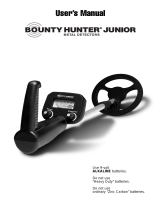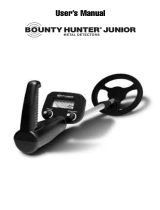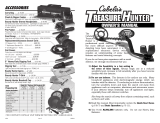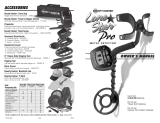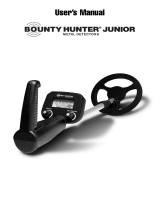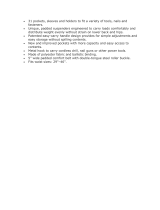Page is loading ...

OWNER’S MANUAL
The
Quick
Silver is an
easy to use detector. The most difficult
aspects of metal detecting have been
automated.
However if you are new to the hobby, we strongly
recommend that you:
1) Adjust the Sensitivity to a low setting in the
event of false signals. The detector powers on a
3/4 sensitivity; increase to full sensitivity after you have
become familiar with the detector
.
2) Do not use indoors. This detector is for outdoor use only. Many
household appliances emit electromagnetic energy
, which can
interfere with the detector. If conducting an indoor demonstration,
turn the sensitivity down and keep the search coil away from
appliances such as computers, televisions and microwave ovens.
If your detector beeps erratically, turn off appliances and lights.
Also keep the search coil away from objects containing metal, such
as floors and walls.
3) Read this manual. Most importantly, review the Quick-Start Demo
(p.6) and Basic Operation (p. 8-12).
4)
Use 9-volt ALKALINE batteries only.
Do not use Heavy Duty or ordinary Zinc-carbon Batteries.

2
TABLE OF CONTENTS
Terminology . . . . . . . . . . . . . . . . . . . . . . . . . . . .3
Assembly
. . . . . . . . . . . . . . . . . . . . . . . . . . . .4-5
Batteries
. . . . . . . . . . . . . . . . . . . . . . . . . . . . . . .6
Quick-Start Demo
. . . . . . . . . . . . . . . . . . . . . .7-8
Basic Operation
Powering Up . . . . . . . . . . . . . . . . . . . . . . . .9
The Display . . . . . . . . . . . . . . . . . . . . . .9-10
Operating Controls . . . . . . . . . . . . . . . . . . . . . .11
Environmental Conditions . . . . . . . . . . . . . . . .12
Audio Target Identification
. . . . . . . . . . . . . . .13
Depth Select (Sensitivity Adjustment) . . . . . . .14
In The Field Techniques
. . . . . . . . . . . . . . .15-16
Trouble Shooting
. . . . . . . . . . . . . . . . . . . . . . .17
Metal Detecting Applications . . . . . . . . . . . . . .18
Treasure Hunter’s Code of Ethics . . . . . . . . . . .19
Warranty
. . . . . . . . . . . . . . . . . . . . . . . . . . . . .19
Accessories
. . . . . . . . . . . . . . . . . . . . .Back Cover

3
TERMINOLOGY
The following terms are used throughout the manual, and are standard
terminology among detectorists.
ELIMINATION
Reference to a metal being "eliminated" means that the detector will
not emit a tone, nor light up an indicator, when a specified object
passes through the coil’s detection field.
DISCRIMINATION
When the detector emits different tones for different types of metals,
and when the detector "eliminates" certain metals, we refer to this
as the detector "discriminating" among different types of metals.
Discrimination is an important feature of professional metal
detectors. Discrimination allows the user to ignore trash and
otherwise undesirable objects.
RELIC
A relic is an object of interest by reason of its age or its association
with the past. Many relics are made of iron, but can also be made
of bronze or precious metals.
IRON
Iron is a common, low-grade metal that is an undesirable target in
certain metal detecting applications. Examples of undesirable iron
objects are old cans, pipes, bolts, and nails.
Sometimes, the desired target is made of iron. Property markers,
for instance, contain iron. Valuable relics can also be composed of
iron; cannon balls, old armaments, and parts of old structures and
vehicles can also be composed of iron.
FERROUS
Metals which are made of, or contain, iron.
PINPOINTING
Pinpointing is the process of finding the exact location of a buried
object. Long-buried metals can appear exactly like the surrounding
soil, and can therefore be very hard to isolate from the soil.
PULL-TABS
Discarded pull-tabs from beverage containers are the most bothersome
trash items for treasure hunters. They come in many different shapes
and sizes. Pull-tabs can be discriminated, but some other valuable
objects can have a magnetic signature similar to pull-tabs, and will also
be eliminated when discriminating out pull-tabs.
GROUND BALANCE
Ground Balancing is the ability of the detector to ignore, or "see
through," the earth’s naturally occurring minerals, and only sound
a tone when a metal object is detected.

4
ASSEMBLY
Adjusting the Arm Rest
The arm rest may be moved
forward or backwards by
removing the single screw and
nut, and then repositioning the
2-piece arm rest. Users with
shorter arms may find the arm
rest more comfortable in the
forward position. In order to
move the arm rest backwards,
the plastic plug must be
removed from the aluminum
tube.
Arm Rest Strap (not included)
Some users prefer to use a strap
when swinging the detector
vigorously, in order to hold the
detector secure against the arm.
The strap may be purchased as
an optional accessory.
The detector can also be used
without the strap with no
compromise to detector balance
and stability under most
conditions.
Knu
rle
d
Knob
Nut
Screw
Cable
Plu
g
Hand-grip
S-Rod
Armrest
Search
Coi
l
Cable
Sea
rch
Co
il
Optional Arm Strap

ASSEMBLY
Assembling your Quick Silver Metal
Detector is easy and requires no
tools. Just follow these steps:
●
1 Using the supplied bolt and
knurled knob, attach the
search coil to the lower stem.
●
2
Press the button on the upper end
of the lower stem and slide the
lower stem into the upper stem.
Adjust the stem to a length
that lets you maintain a com-
fortable upright posture, with
your arm relaxed at your
side. Maintain the search coil
about 1 inch above the
ground as you sweep.
●
3 Wind the search coil cable
around the stem. Leave
enough slack in the cable to let
you adjust the coil when you
are hunting on uneven
ground. Then tighten the knob
at the end of the search coil.
Note:
To adjust the coil,
simply loosen the knob.
●
4 Insert the coil’s plug into the
matching connector on the
control housing. Be sure the
holes and pins line up correctly.
Caution:
• Do not force the plug in.
Excess force will cause damage.
• To disconnect the cable, pull
out the plug. Do not pull on
the cable.
5

6
IMPORTANT: Always use ALKALINE batteries only.
Do not use heavy duty batteries.
DON’T MIX OLD AND NEW BATTERIES
Always remove the batteries for prolonged storage.
CHECK THE BATTERIES if your detector exhibits any of the following
symptoms:
●
1 The unit does not turn on.
●
2 Low speaker volume.
●
3
Unit beeps continuously or erratically.
The LOW BATTERY indicator will come on and stay on if the batteries
are discharge. You may notice erratic beeping if using with LOW
BATTERY illuminated.
IMPORTANT: Your Quick Silver metal detector requires two 9-Volt
ALKALINE batteries.
Follow these steps to install the batteries.
●
1 Carefully remove the battery compartment door by pressing the release
clip on the right side of the door.
●
2 Snap one
battery onto
each of the
terminals and
place the bat-
teries inside the
compartment.
Insert booth of
the batteries
with terminals
facing inward.
●
3
Replace the
compartment
door by carefully
inserting oppo-
site side of clip
first. Then press
BATTERIES
Release
Clip
Both Batteries
teminals
facing in

7
Q
UICK-START DEMONSTRATION
I. Supplies Needed
• A Medium-Size Nail • A Quarter
• A Nickel • A Zinc Penny (dated after 1982)
II. Position the Detector
a. Place the detector on a
table, with the search coil
hanging over the edge.
(or better
, have a friend
hold the detector, with
the coil off the ground)
b. Keep the search coil
away from walls, floors,
and metal objects.
c. Remove watches, rings and other jewelry or metal objects from
hands and wrists.
d. Turn off appliances or lights that cause electromagnetic
interference.
e. Pivot the search coil back toward the detector body.
III. Power Up
Press the ON touchpad.
The detector will beep
several times and the
sensitivity setting will
be indicated on the
right of the display
. Two
illuminated segments
indicates 3/4 sensitivity.
IV. Wave each Object over
the Search Coil (
pass the flat side of the coins parallel to the coil)
a.Notice a different tone for each object.
Low Tone: Nail
Medium Tone: Nickel & Zinc Penny
High Tone: Quarter
b.
Motion is required. Objects must be in motion over the
search coil to be detected.
V. Press the TARGET REJECT
touchpad

8
a. An “X” will appear under
the IRON segment.
b. The “X” tell us that Iron
has been eliminated from
detection.
VI. Wave the Nail over the
Search Coil
a. The Nail will not be
detected.
b. The Nail has been "Discriminated Out."
VII. Wave the Quarter, Penny, and Nickel over the Search Coil
These non-ferrous objects will be detected with their own
distinctive tones.
VIII. Press the TARGET
REJECT
touchpad again
Another “X” will
illuminate under “AL ZN”.
IX. Wave all objects over the
Search Coil
The Zinc Penny will not be detected. make sure the penny is post-
1982; these are made of Zinc. CAUTION: some zinc pennies
within 1/2” of the coin surface will induce a high tone.
X. Press the TARGET REJECT touchpad again
a. A third “X” appears.
b. Pass all object over the search coil.
The nail, penny, and nickel are all eliminated from detection.
XI. Press the TARGET REJECT touchpad to return the detector to all-
metals detection, with no “X”s illuminated.
Q
UICK-START DEMONSTRATION
USING HEADPHONES
Using headphones (not included) improves battery life, and prevents the
sounds from annoying bystanders.
It also allows you to hear subtle changes in the sound more clearly, particularly
if searching in a noisy location. For safety reasons, do not use headphones
near traffic or where other dangers are present. This device is to be used with
interconnecting cables/headphone cables shorter than three meters.

BASIC OPERATION
POWERING UP
Press the ON touch pad.
All display indicators will illuminate momentarily
The inverted-pyramid depth-selection indicator on the right of the
display will stay illuminated.
UNDERSTANDING THE DISPLAY
●
1 DEPTH SELECT
The detector default to 3/4
sensitivity, indicated by two
illuminated segments. To change
the depth range of the detector,
and thus its sensitivity to more
deeply buried objects, use the
DEPTH SELECT touch pad. each
touch of DEPTH SELECT toggles
the detector among three different sensitivity settings. The detector is
at maximum depth capability when three depth segments are
illuminated on the right of the display.
At the maximum depth setting, the detector will detect a coin-sized
object buried approximately 6 1/2 inches beneath the surface. With
two depth segments illuminated, the detector’s depth range will be
reduced to 80%, and with one depth segment illuminated, the range
will be reduces to 65%.
A more detailed explanation of depth selection is found on page 14.
●
2 LOW BATTERY
The LOW BATTERY indicator will illuminate when the 9-volt batteries
are discharged to a level of 6.8 volts.
Replace the batteries as soon as
possible after receiving th e low
battery indication. The detector
will begin to beep erratically and
operate unreliably if continuing
use with discharged batteries.
To save on batteries, check each
battery individually, as the two
batteries can discharge at different
rates. When LOW BATTERY
illuminates, it is possible that only one of the batteries requires
replacement.
Under normal conditions, a set of batteries will last for approximately
16 hours in the field, depending upon the brand of battery.
9

10
BASIC OPERATION
●
3 PROBABLE TARGET
The four categories depicted across the top of the display
indicate the probable identification of buried, detected metal
objects. The search coil must be in motion over an object to
be detected. Alternatively, you can pass an object over a
motion less search coil to test your detector. One of the four
target indicators will illuminate, indicating the probable
identification of the object. The indicator will remain
illuminated until another object is detected.
You will encounter a never-ending variety of buried metal
objects. It is therefore impossible to accurately identify all
buried metal objects. The target identification system will
accurately identify the most common items.
Commonly-found object are classified into the four categories as
follows:
IRON ------------------------------------------------
Ferrous objects
Metals composed mostly or
entirely of iron
Most very small metals objects
Small foil pieces; small gold
pieces.
AL 5¢ ------------------------------------------------
Large gold rings
Newer pull-tabs (those which
stay connected to can)
Nickels
Large Aluminum Pieces
AL ZN ------------------------------------------------
Post-1982 pennies (are made of
zinc, some zinc pennies will register
as coins within 1” of the coil). -Zinc
coins, such as recent foreign
currency -Most bottle screw caps. -
Large foil pieces. -Many rings; most
gold rings. -Older pull-tabs (those
which detach from the can)
COINS ------------------------------------------------
Silver coins, like dimes and
quarters. -Copper pennies (pre-
1982). -Very large metal objects
like manhole covers.

11
●
4 REJECTED TARGET
When “X” appears under a target
category, objects falling into this
category are eliminated from
detection. This feature is commonly
referred to as target discrimination.
With each press of the REJECT
TARGET touch ad, you will
progressively eliminate, from left to
right, the common, less desirable, targets. When all three “X” are
illuminated, the next press will erase all “X”s, returning the detector to
all-metal detection status, where all types of metals will be detected.
OPERATING CONTROLS
The Quick Silver is the most automated, easy-to-operate, professional
metal detector ever designed. It is designed for those who are new to the
hobby providing maximum basic target discrimination, while requiring
minimal operator adjustment.
DEPTH SELECT
With each press of the DEPTH SELECT
touch pad, the detector toggles among
three different depth-detection levels.
Each of these sensitivity levels is
identified through the 3-segment depth-
select icon on the right of the display.
When three segments are illuminated,
the detector is at maximum sensitivity. As you press the DEPTH SELECT
touch pad, the detector toggles among the three different sensitivity levels.
A more detailed explanation of depth selection is found on page 14.
TARGET REJECT
Upon power-up, all types of metals are
detected. The TARGET REJECT touch
pas allows the user to eliminate
undesirable metals from detection.
With each press of the REJECT TARGET
touch pad, unwanted metals are
progressively eliminated, from left to right on the display. When all three
“X”s are illuminated, the next press will erase all “X”s, returning the detector
to all-metal detection status, where all types of metals will be detected.
BASIC OPERATION

12
BASIC OPERATION
ENVIRONMENTAL CONDITIONS
WATER HUNTING: Your Quick Silver is ideal for damp grass and shallow
water spots. the search coil is waterproof; the case and case-to-cable
connection is not. Be careful to keep the detector body dry.
In
saltwater, keep the search coil from contact with the ground. Contact
with saltwater sands will cause the detector to beep falsely. For best
result in saltwater, eliminate IRON to reduce false signals caused by
conductive beach sands. Coil sweep technique is also important in
saltwater; keeping the coil submerged is better than dunking and lifting.
The detector needs time to readjust to the conductive salt water.
RED CLAY: The red clay earth found in the southwestern U.S. may
require a reduction in the DEPTH SELECT level if encountering false
signals. Coil sweep technique is also more critical in red clay; keep the
coil level with the ground. Do not lift the coil at the ends of your sweep.
Review coil sweep technique on page 15.
RED SANDS: Red sand found in desert locations will react like red clays,
so fallow the same precautions as outlined in the paragraph above.
BLACK SANDS: The most promising gold prospecting locations can
contain large amounts of black sand. This black sand is the most
demanding detecting environment, and frequently requires a detector
costing thousands of dollars for the best results. Your Quick Silver will still
function in these conditions, but will usually require operation at reduced
sensitivity levels. If you receive constant false signals, reduce the
sensitivity or move to another area.
SAND: Dry beach sands are no problem for the Quick Silver. if the sand
is damp with saltwater, however, follow the precautions outlined under
saltwater above.
HOT AND COLD: Be patient if moving immediately between hot and
cold environments, like taking your detector from your air-conditioned
home into a blazing summer sun. The search coil is constructed of
copper wire which will expand and contract with temperature change.
Your detector may require 10 to 15 minutes to stabilize to the ambient
temperature.

13
AUDIO TARGET IDENTIFICATION
While the LCD (Liquid Crystal Display) is very accurate in identifying
buried objects, the user in the field does not always maintain the display
screen in his field of vision. Therefore, we have incorporated an audio
feedback mechanism to alert the user to the nature of buried objects.
This audio feedback system first alerts the user to the presence and
classification of objects, whose nature and location can be confirmed
using the LCD display.
The detector will sound one of three different tones, depending on the
type of metal detected.
BASS TONE
Ferrous objects, such as iron and steel, will induce a bass tone.
The smallest gold objects can also induce a bass tone.
MEDIUM TONE
Pull-tabs, newer pennies (post-1982), larger gold objects, zinc,
small brass objects, and most bottle screw caps will induce
medium tones. Many recent vintage foreign currencies will
induce medium tones. Medium tone objects will illuminate the
two center target indicators.
HIGH TONE
Silver and copper coins, larger brass objects, older pennies (pre-
1982), and highly oxidized metals will induce high tones.
Quarters, dimes and other precious coins fall into this category.
Audio Target Identification (ATI) classifies metals into four categories.
LOW TONE
Nails, Bottle Caps,
& Smaller Gold
MEDIUM TONE
Old & New Pull Tabs, Zinc
Pennies (Post 1982), Nickel,
Larger Gold Objects
HIGH TONE
Copper, Silver & Brass
Copper Pennies (Pre 1982)

14
DEPTH SELECT
(Sensitivity Adjustment)
Upon power-up, the detector defaults to 3/4 sensitivity. To increase to full
sensitivity, press the DEPTH SELECT touchpad once.
ELECTROMAGNETIC INTERFERENCE
The principle use for the Sensitivity Control is to eliminate
Electromagnetic Interference (EMI).
A hobby metal detector is an extremely sensitive device; the search coil
creates its own magnetic field and acts like an antenna. If your detector
beeps erratically when the search coil is motionless, the unit is probably
detecting another electromagnetic field.
Common sources of EMI are electric power lines, both suspended and
buried, motors, and household appliances like computers and
microwave ovens. Some indoor electronic devices, such as dimmer
switches used on household lighting, produce severe EMI and can cause
the detector to beep erratically. Other metal detectors also produce their
own electromagnetic fields; so if detecting with a friend, keep two metal
detectors at least 20 feet apart.
If the detector beeps erratically, REDUCE THE SENSITIVITY by using the
Depth Select Control.
SEVERE GROUND CONDITIONS
A secondary use for the Sensitivity Control is to reduce false detection
signals caused by severe ground conditions. While your Quick Silver
contains circuitry to eliminate the signals caused by most naturally
occurring ground minerals, 100% of all ground conditions cannot be
anticipated. Highly magnetic soils found in mountainous and gold-
prospecting locations can cause the detector to emit tones when metal
objects are not present. High saline content soils and sands can also
cause the detector to false.
If the detector emits false, non-repeatable, signals, REDUCE THE
SENSITIVITY.
MULTIPLE TARGETS
If you suspect the presence
of deeper targets beneath a
shallower target, reduce the
sensitivity to eliminate the
detection of the deeper
targets, in order to properly
locate and identify the
shallower target.

15
IN THE FIELD TECHNIQUES
When pinpointing a target, try drawing an “X”,
as illustrated, over where the tone is induced.
PINPOINTING
Accurate pinpointing takes practice
and is best accomplished by
“X-ing” the target area.
1. Once a buried target is indicated
by a good tone response,
continue sweeping the coil over
the target in a narrowing
side-to-side pattern.
2. Take visual note of the place on
the ground where the “beep”
sounds.
3. Stop the coil directly over this
spot on the ground.
4. Now move the coil straight
forward and straight back
towards you a couple of times.
5. Again make visual note of the
spot on the ground at which
the “beep” sounds.
6. If needed, “X” the target at
different angles to “zero in” on
the exact spot on the ground at
which the “beep” sounds.
COIL MOVEMENT
When swinging the coil, be
careful to keep it level with the
ground about one inch from the
surface. Never swing the coil like
a pendulum.
TARGET DEPTH ESTIMATION
After verifying a desirable
target, pass the coil again, but
raise the coil 1” over the
ground, progressively higher
with each sweep. Note the coil
elevation at which the signal
disappears. With practice, you
will be able to approximate
target depth.
CORRECT
WRONG

16
Swing the search coil slowly,
overlapping each sweep as you
move forward. It is important to
sweep the coil at a consistent speed
over the ground as you search. After
identifying a target, your sweep
technique can help in identifying both
the location and the nature of the
target. If you encounter a weak
signal, try moving the coil in short,
rapid sweeps over the target zone;
such a short rapid sweep may
provide a more consistent target
identification.
Most worthwhile objects will
respond with a repeatable tone. If
the signal does not repeat after
sweeping the coil directly over the
suspected target a few times, it is
more than likely trash metal.
Crossing the target zone with
multiple intersecting sweeps at
multiple angles is another way to
verify the repeatability of the signal,
and the potential of the buried target.
To use this method, walk around the
target area in a circle, sweeping the
coil across the target repeatedly,
every 30 to 40 degrees of the circle,
about ten different angles as you
walk completely around the target. If
a high-tone target completely
disappears from detection at a given
angle, chances are that you are
detecting oxidized ferrous metals,
rather than a silver or copper object.
If the tone changes at different
angles, you may have encountered
multiple objects. If you are new to
the hobby, you may want to dig all
targets at first. With practice in the
field, you will learn to better discern
the nature of buried objects by the
nature of the detector’s response.
You may encounter some false
signals as you proceed. False signals
occur when the detector beeps, but
no metal target is present. False
signals can be induced by
electromagnetic interference,
oxidation, or highly mineralized
ground soils. If the detector beeps
once, but does not repeat the signal
with several additional sweeps over
the same spot, there is probably no
target present.
When searching very trashy ground,
it is best to scan small areas with
slow, short sweeps. You will be
surprised just how much trash metal
and foil you will find in some areas.
The trashiest areas have been
frequented by the most people, and
frequently hold the most promise for
finding the most lost valuables.
Also maintain the search coil
positioned just above the surface of
the ground, without making contact
with the ground. Making contact with
the ground can cause false signals.
WHAT
READS
LIKE THIS
…MAY
ACTUALLY
BE THIS
IN THE FIELD TECHNIQUES

17
TROUBLESHOOTING GUIDE
SYMPTOM CAUSE SOLUTION
Detector chatters • Using detector • Use detector
or beeps erratically indoors outdoors only
• Using detector near • Move away
power lines
from power lines
• Using 2 detectors in • Keep 2 detectors
close proximity at least 30’ apart
• Highly oxidized • Only dig up
buried object repeatable
signals
• Environmental •
Reduce sensitivity
electromagnetic until erratic
interference signals cease
Constant low tone •
Discharged batteries
• Replace batteries
or
constant repeating
• Wrong type of • Use only 9V
tones
batteries alkaline batteries
LCD does not lock • Multiple targets •
Move coil slowly
on to one target ID present at different angles
or detector emits • Highly oxidized
multiple tones target
• Sensitivity set • Reduce sensitivity
too high
No power, no • Dead batteries • Replace batteries
sounds
• Cord not connected •
Check connections
securely
• Not moving •
Sweep search coil
Search Coil from side-to-side
TROUBLESHOOTING

18
METAL DETECTING APPLICATIONS
COIN SHOOTING:
The most popular metal detecting activity.
Find coins where people congregate frequently. Many detectorists revisit the
same areas again and again to find a never-ending treasure trove as people
continue to lose valuables every day. Parks, fairgrounds, and play ares are
good choices. The most valuable old coins are frequently found in abandoned
home sites, or if you live on an older property, maybe in your own backyard.
Control settings required. Target-Rejected al least 2-Xs to eliminate iron,
foil, and old pull tabs. Target-Rejected all 3-Xs if you want to find only
copper and silver. If you search for nickels, remember that you will also
encounter some newer pull-tabs. Some newer pull-tabs have a magnetic
signal indistinguishable from nickel.
RELIC HUNTING:
The most effective relic hunting is best accomplished after conducting historical
research. Visit your local library, or check the internet, for historical events in
your area. You can target specific areas and gain valuable insight into your local
history. Remember to ask permission and respect laws regarding private and
government property.
Control settings required. No X’s should be displayed. Do not
discriminate out any types of metals as many of the oldest relics contain
iron.
JEWELRY HUNTING:
This is the most challenging treasure hunt. Gold rings will register in the same
range as pull-tabs. Necklaces will register with zinc and foils. You will dig up
many trash items in your search for jewelry, but jewelry hunting holds the
most potential for reward. Please pick up ant throw away those pull-tabs to
help clean the environment.
Control settings required. Target-Reject only the 1st X; eliminate IRON
only.
JEWELRY HUNTING:
A cache, pronounced “cash,” is a buried or hidden valuable stored inside a
case, can, strong gox, or bag. A cache could be the loot from a bank robbery
or someone’s life savings. Caches can be hidden in floors or walls of an old
house, or buried nearby.
Control settings required. No X’s should be display. The container
holding the treasure will frequently be a ferrous object, so you want to
detect all types of metal objects.

19
5-YEAR LIMITED WARRANTY
The Quick Silver metal detector is warranted against defects in materials and
workmanship under normal use for five years from the date of purchase to the origi-
nal owner.
Damage due to neglect, accidental damage, or misuse of this product is not cov-
ered under this warranty. Decisions regarding abuse or misuse of the detector
are made solely at the discretion of the manufacturer.
Proof of Purchase is required to make a claim under this warranty.
Liability under this Warranty is limited to replacing or repairing, at our option, the
metal detector returned, shipping cost prepaid to First Texas Products. Shipping
cost to First Texas Products is the responsibility of the consumer.
To return your detector for service, please first contact First Texas for a Return
Authorization (RA) Number. Reference the RA number on your package and
return the detector within 15 days of calling to:
First Texas Products L.L.C.
1465-H Henry Brennan Dr.
El Paso, TX 79936
Phone: 915-225-0333
NOTE TO CUSTOMERS OUTSIDE THE U.S.A.
This warranty may vary in other countries, check with your distributor for details.
Warranty does not cover shipping costs.
According to FCC part 15.21 Changes or Modifications made to this device not expressly approved by
the party responsible for compliance could void the users authority to operate this equipment.
This device complies with FCC Part 15 Subpart B Section 15.109 Class B.
Copyright
©
2012 by First Texas Products, L.L.C.
All rights reserved, including the right to reproduce this book, or parts thereof, in any form,
except for the inclusion of brief quotations in a review.
Published by First Texas Products, L.LC.
Bounty Hunter
®
is a registered trademark of First Texas Products, L.L.C.
www.detecting.com
1465-H Henry Brennan • El Paso, TX 79936 • (915) 633-8354
TREASURE HUNTER’S CODE OF ETHICS:
• Always check Federal, State, County and local laws before searching.
• Respect private property and do not enter private property without the owner’s permission.
• Take care to refill all holes and leave no damage.
• Remove and dispose of any and all trash and litter found.
• Appreciate and protect our inheritance of natural resources, wildlife and private property.
• Act as an ambassador for the hobby, use thoughtfulness, consideration and courtesy at all times.
• Never destroy historical or archaeological treasures.
• All treasure hunters may be judged by the example you set; always conduct yourself with
courtesy and consideration of others

ACC ESSORIES
FOR COMPLETE DETAILS VISIT WWW.DETECTING.COM • 1-800-413-4131
Carry Bag
Rugged double-stitched construction - CBAG-W
Pouch & Digger Combo
Pouch with 2 large pockets & 9” heavy duty digging tool. TP-KIT-W
Bounty Hunter Stereo Headphones
.
Use with Bounty Hunter metal detectors. Lightweight and adjustable with
true stereo sound, adjustable volume, 1/8 jack with 1/4 adaptor,
4’ cable.
HEAD-W
Pin Pointer
Pinpoints the exact location of buried metal objects. Audio signal indicator
and vibrator. Runs on 1 – 9-Volt Battery. PIN POINTER-W
Sand Scoop
Large scoop with filtering holes. Made of strong plastic. SAND SCOOPBH
Replacement/Accessory Search Coils
10” Magnum Accessory Coil – 10COIL
8” Replacement Standard Coil – 8COIL-N
4” Accessory Coil – 4COIL
Coil Covers
Protect your coil from abrasion and damage.
10” Coil Cover – 10COVER
8” Coil Cover – 8COVER-N
4” Coil Cover – 4COVER
9” Heavy-Duty Digging Tool
Metal blade with comfortable plastic handle and depth gauge TROWEL-2
Digging Tool
Light and practical wide blade digging tool. TROWEL-W
Bounty Hunter T-Shirt
100% cotton with Bounty Hunter
®
Logo. Sizes – LG, XL & XXL
Bounty Hunter Baseball Cap
One size fits all, with Bounty Hunter
®
logo.
Gold
Prospecting Kits
MQSI REV.3 102912
/


